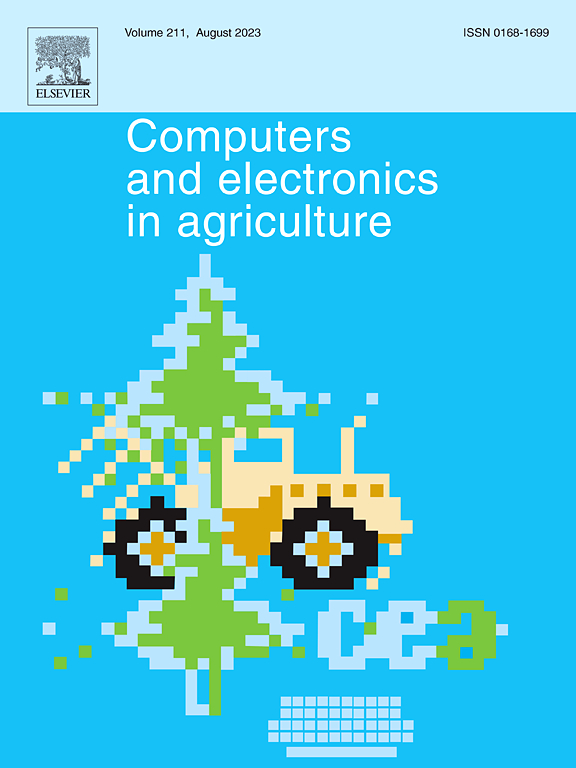TDDet: A novel lightweight and efficient tea disease detector
IF 8.9
1区 农林科学
Q1 AGRICULTURE, MULTIDISCIPLINARY
引用次数: 0
Abstract
Tea diseases cause significant economic losses to the tea industry every year, and thus developing a rapid and accurate tea disease detector is of great significance for assisting farmers in preventing diseases and increasing their income. Therefore, this paper proposes a lightweight and efficient detector called TDDet to quickly and accurately detect tea diseases. TDDet is mainly composed of two key innovations: feature extraction and feature aggregation. For feature extraction, we use lightweight depthwise separable convolution to reduce the computational load and enhance the ability to extract key local features in images of tea diseases. In addition, attention mechanisms including channel-, spatial-, and self-attentions, are employed to enable the model to focus on the most important parts of tea diseases, thereby improving the performance of the model. For feature aggregation, we propose a novel Cross-scale Feature Fusion (CFF) module to focus on tea disease areas, boosting the model’s sensitivity to feature details. Based on CFF, TDDet repeatedly fuses multiscale features of different levels in a top-down and bottom-up manner, enhancing feature representation capability. Besides, a lightweight and efficient upsampling module, called Dysample, is used to reduce computational costs and improve model performance by dynamically adjusting the sampling rate of feature maps. Experimental results demonstrate that TDDet with fewer parameters outperforms other state-of-the-art object detection models, enabling fast and accurate identification of tea diseases. Our code and dataset are available at https://github.com/hpguo1982/TDDet.
TDDet:一种新型、轻便、高效的茶病检测仪
茶病每年都给茶业造成巨大的经济损失,因此开发一种快速准确的茶病检测仪对于帮助农民防病增收具有重要意义。为此,本文提出了一种轻量级、高效的TDDet检测仪,能够快速、准确地检测出茶叶病害。TDDet主要由两个关键创新组成:特征提取和特征聚合。在特征提取方面,我们采用轻量级深度可分离卷积来减少计算量,增强提取茶病图像关键局部特征的能力。此外,利用通道注意、空间注意、自注意等注意机制,使模型能够关注茶病最重要的部分,从而提高模型的性能。在特征聚合方面,我们提出了一种新的跨尺度特征融合(Cross-scale feature Fusion, CFF)模块,以关注茶叶病害区域,提高模型对特征细节的敏感性。基于CFF, TDDet以自顶向下和自底向上的方式反复融合不同层次的多尺度特征,增强了特征表示能力。此外,采用轻量级高效的上采样模块Dysample,通过动态调整特征映射的采样率,降低了计算成本,提高了模型性能。实验结果表明,参数较少的TDDet模型优于其他最先进的目标检测模型,能够快速准确地识别茶叶病害。我们的代码和数据集可在https://github.com/hpguo1982/TDDet上获得。
本文章由计算机程序翻译,如有差异,请以英文原文为准。
求助全文
约1分钟内获得全文
求助全文
来源期刊

Computers and Electronics in Agriculture
工程技术-计算机:跨学科应用
CiteScore
15.30
自引率
14.50%
发文量
800
审稿时长
62 days
期刊介绍:
Computers and Electronics in Agriculture provides international coverage of advancements in computer hardware, software, electronic instrumentation, and control systems applied to agricultural challenges. Encompassing agronomy, horticulture, forestry, aquaculture, and animal farming, the journal publishes original papers, reviews, and applications notes. It explores the use of computers and electronics in plant or animal agricultural production, covering topics like agricultural soils, water, pests, controlled environments, and waste. The scope extends to on-farm post-harvest operations and relevant technologies, including artificial intelligence, sensors, machine vision, robotics, networking, and simulation modeling. Its companion journal, Smart Agricultural Technology, continues the focus on smart applications in production agriculture.
 求助内容:
求助内容: 应助结果提醒方式:
应助结果提醒方式:


